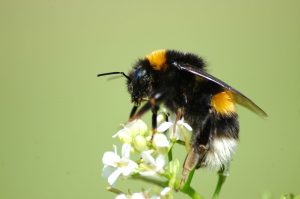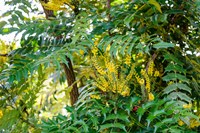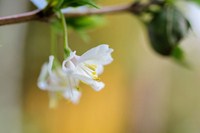You might think winter is not a good season for flowers and so bees simply hibernate. This used to be the case and still is in much of our countryside. But in recent years we have had some very mild winters (particularly in towns and cities). This combined with an influx of garden plants that flower even in deepest winter (many of which are not native to the UK) has meant that pollinating insects, include winter-active bees can thrive all year round.
The buff-tailed bumblebee (Bombus terrestris) maintains winter-colonies mainly in the south of the UK.

Bees active during the winter face loss competition and can collect nectar and pollen very efficiently. You can help winter-active pollinators by planting winter-flowering perennials, shrubs, bulbs and climbers in your garden and at the same time enjoy some colour and scent.
Winter-flowering plants:
 Mahonia – starts flowering from November onwards (depending on the species) and the scented yellow nectar and pollen-rich flowers attract bees. A large shrubs with often spiny leaves so needs space to grow. Plant in well-drained soil in full sun or part shade.
Mahonia – starts flowering from November onwards (depending on the species) and the scented yellow nectar and pollen-rich flowers attract bees. A large shrubs with often spiny leaves so needs space to grow. Plant in well-drained soil in full sun or part shade.
 Winter-flowering honeysuckle (Lonicera fragrantissmima) – is a deciduous evergreen shrub up to 2 m tall with very fragrant white flowers which open from December onwards. Grow in moist but well-drained soil in full sun or part shade.
Winter-flowering honeysuckle (Lonicera fragrantissmima) – is a deciduous evergreen shrub up to 2 m tall with very fragrant white flowers which open from December onwards. Grow in moist but well-drained soil in full sun or part shade.
 Strawberry tree (Arbutus unedo) – is a large evergreen shrub with small bell-shaped white to pinkish flowers which open in November and December. The Strawberry tree thrives in a sheltered spot on well-drained soil in full sun.
Strawberry tree (Arbutus unedo) – is a large evergreen shrub with small bell-shaped white to pinkish flowers which open in November and December. The Strawberry tree thrives in a sheltered spot on well-drained soil in full sun.
 Lungwort (Pulmonaria) produces blue, pink or lilac flowers in late winter, set against white-spotted foliage, in early spring. It makes good ground cover in a moist, shady spot.
Lungwort (Pulmonaria) produces blue, pink or lilac flowers in late winter, set against white-spotted foliage, in early spring. It makes good ground cover in a moist, shady spot.